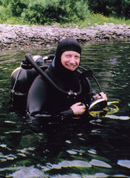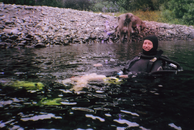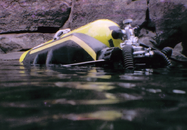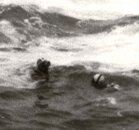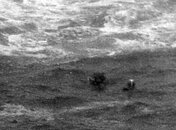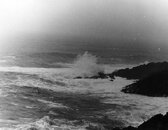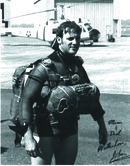Waterwulf, I tried making those arguments in the 1980s, to no avail. As Terry above states, most divers now travel, and don't like anything that is not integrated. They also don't like straps. Well, I grew up with straps, and decided with my Para-Sea BC to incorporate the parachute harness design into one of scuba.
Now, on December 8th, 1974 I had an experience much like yours. I was using my Bill Herder wetsuit with a BCD built into its back, but also wearing a front-mount life vest. Here's what my dive log (I wrote extensively about this incident) says about that dive plan:
DIVE PLAN: swim out into waves, test back swimming concept and observe marine life while helping Bruce* stabilize for underwater macro photography; turned out much different & spent almost 3 hours in the water.
In short, we went out after watching the water off Otter Crest, Oregon for almost half an hour. While out, the waves changed from dive-able to much larger. Here's my dive log narration:
On bottom--found we were on sand bottom & apparently in a rip channel. swam right (north) and got to the rocks--surge was unusually heavy. Hung onto rock (see observations) and was flipped each way violently. Lost hold--tent to top of rock & found a hole. Tried to wedge myself into it (hole) but couldn't do it because Bruce was free and pulling. Decided to let go & go out. We started really going out in the rip. I gave the danger signal and signed to surface.
Bruce and I were tied together with a 1/4 inch nylon line, two brass connectors, and two waist straps made of parachute webbing (2 inches wide) with D-rings sewn into the webbing. There was no way we were going to get separated.
We made a "1st Abortive try to exit." Here's what I wrote in my dive log:
A. We surfaced--I inflated my back (wet suit), spit out my mouthpice & began swimming in on my back; Bruce began snorkeling in with me.
B. I was looking seaward, Bruce toward he shore; I remember saying "Bruce--there's a big one (wave) coming" and searching for my regulator. Before I found it, the wave broke over us. I was tumbling feet over head & xtotally unaware of Bruce & the buddy line (w/I still hand in my left hand). I was aware of three things 1. Tumbling 2. Somethig pulling & twisting my right leg--felt like my fin would come off 3. I was painfully aware that I had no air supply & was beginning to hurt for air. I tried reaching around for my regulator & was unsuccessful. At this point I was starved for air & decided to just relax. If I was "buying the farm" it would be relaxed. I still reached unsuccessfully trying for the regulator. At this point where I was almost expecting blackout, I was suddenly on he surface & breathing--At no point did I chock on sea water although (later I found out) my sinuses were completely filled w/ sea water.
C. Bruce was also on the surface--and we were looking at each other to see if everything was still intact--the buddy line had held. I was stairght up in the water, looking seaward (3/4 flip), Bruce was looking at me. 'Got regs in mouth & breathed sweet, dry air.
D. We both decided that this wasn't the place to be, and we looked seaward. ZAfter getting out, we spent a long time regaining our wits. While swimming out I gane an "Okay" signal to the girls--meaning we were physically okay. We thought it was rather obvious that we were in an emegency.
At this point both Bruce and I dropped our weight belts, and inflated our front-mounted vests. Both Bruce and I were wearing helmets, but Bruce's was held only by Velcro, and mine was was held by a nylon strap and double D-rings. We drifted for a long time, hours actually. Our girl friends by this time had called the Coast Guard, and unknown to us they were on the way. We had been in the water over two hours tow, with waves running 15-20 feet. We watched as the light began to fad, and cars on Highway 101 turned on their lights. We started to think about how it would be to spend the night in the water. At one point, we were close to Whale Cove, which we thought could be an exit point, but then saw waves breaking clear across the entrance to the cove.
We were about to think about staying out the night, when I saw a Coast Guard cutter out beyond us. I waved, and they saw my helmet (which had a white strip on it), turned in and came along side of us. We flippered up and into the cutter, and were very grateful to be in the boat. They were equally happy to rescue us, as we were their first live rescues in over a year (they had picked up several bodies prior).
From this I started re-designing my dive equipment, which ultimately led to my devising the Para-Sea BC. I don't travel to dive, and I like straps. I have been trained in parascuba jumping as an Air Force Pararescueman, so I had no problem with straps. A parachute harness is much more comfortable than a crotch strap/waist strap on a conventional vest design, and with hip connectors, I had a wonderful attachment for the scuba that also eliminated the waist strap. So I thought I had a very successful, and very safe, design, as it provided the buoyancy in front, kept an unconscious diver face-up, and still provided good buoyancy control and trim while underwater. But dive companys (I approached several) didn't like the design, so it as a very expensive, and time consuming experiment.
SeaRat
*Bruce Higgins was my dive buddy, and our two girl friends called the Coast Guard (as briefed before the dive) exactly when they should have. The photos below show this dive, taken by our girl friends. The first was before the wave broke over us, and the second after (note Bruce not having his helmet in the second photo). The third simply documented the waves crashing into the coast at Rocky Creek. The fourth was of me in parascuba gear as a USAF Reserve Pararescueman with the 304th Aerospace Rescue and Recovery Squadron, Portland, Oregon in 1975.



